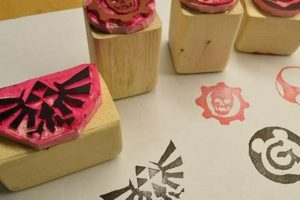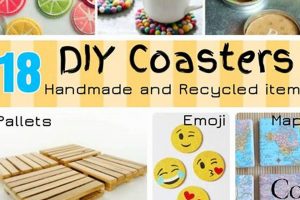Creative projects incorporating reflective surfaces allow for personalized home dcor and artistic expression. These projects encompass a range of techniques, from mosaic applications to framed embellishments, offering avenues for both functional and aesthetic enhancements within a living space. For example, a plain tray can be transformed by adhering small pieces of reflective material, creating a unique and eye-catching serving piece.
The incorporation of reflective elements into do-it-yourself projects holds significant value due to its capacity to amplify light, creating the illusion of expanded space and adding visual interest to interiors. Historically, reflective surfaces have been utilized not only for their practical purpose but also as decorative features in various cultures, signifying wealth, status, and artistic refinement. The practice of incorporating such elements in handcrafted objects allows individuals to personalize their surroundings while embracing time-honored artistic traditions.
The subsequent sections will delve into specific techniques for crafting decorative and functional items incorporating reflective components, providing detailed instructions and exploring the diverse materials and methods available for achieving professional-quality results. This will include discussions on surface preparation, adhesive selection, cutting techniques, and safety precautions necessary for successful completion of diverse projects.
Tips for Projects Involving Reflective Surfaces
Successful integration of reflective components into handcrafted items requires meticulous planning and execution. The following tips offer guidance to ensure optimal results and longevity.
Tip 1: Surface Preparation is Paramount. Prior to adhering any reflective pieces, the base surface must be thoroughly cleaned and dried. Remove any dust, grease, or residue that could compromise adhesion. A slightly roughened surface may improve the bond in certain applications.
Tip 2: Select Appropriate Adhesives. Choose adhesives specifically designed for bonding reflective surfaces to the chosen substrate. Avoid using harsh solvents or acids that could damage the reflective coating. Consider testing the adhesive on a small, inconspicuous area first.
Tip 3: Prioritize Precise Cutting Techniques. Accurate cuts are essential for achieving a professional finish. Employ specialized tools such as glass cutters or mosaic nippers, depending on the material type. Always wear appropriate safety gear, including eye protection, when cutting reflective materials.
Tip 4: Consider Grout Selection Carefully. When working with mosaic projects, carefully consider the grout color and type. A contrasting grout can highlight the individual pieces, while a color-matched grout can create a more seamless appearance. Ensure the grout is suitable for use with reflective surfaces to prevent scratching or discoloration.
Tip 5: Implement Proper Sealing Measures. Once completed, seal the finished project with a suitable sealant to protect it from moisture and environmental damage. This step is particularly crucial for items placed in bathrooms or kitchens.
Tip 6: Address Weight Considerations. The addition of reflective elements can significantly increase the weight of an object. Ensure that the structure or hanging mechanism is sufficiently robust to support the added weight. Employ appropriate hanging hardware for wall-mounted items.
Tip 7: Exercise Patience and Precision. Projects incorporating reflective pieces often require meticulous attention to detail. Rushing the process can result in errors or subpar results. Allow ample time for each step, ensuring that all components are properly aligned and secured.
Adhering to these guidelines will help maximize the aesthetic appeal and longevity of handcrafted items featuring reflective elements, while minimizing the risk of damage or structural failure.
The subsequent section will address common challenges encountered during the creation process, providing solutions and preventative measures for achieving optimal outcomes.
1. Reflection Quality
Reflection quality constitutes a foundational attribute within the realm of handcrafted items incorporating reflective elements. Its influence manifests in the project’s visual impact, dictating the degree to which light is amplified, the perceived spatial dimensions are altered, and the overall aesthetic appeal is enhanced. Substandard reflection quality, resulting from imperfections in the reflective coating or the presence of distortions, can diminish the perceived value of the craft, rendering it visually unappealing and detracting from the intended design. For instance, a handcrafted vanity mirror with a clouded or scratched surface will fail to provide a clear reflection, thereby compromising its functionality and negating the decorative intent.
The correlation between reflection quality and the perceived value and effectiveness of a handcrafted piece is directly proportional. A high-quality reflective surface, characterized by clarity, evenness, and minimal distortion, maximizes light reflection, creating a brighter and more visually expansive environment. Conversely, a low-quality surface diminishes light, potentially introducing visual artifacts that detract from the overall design. As an example, consider mosaic art using reflective tiles; tiles with inconsistent or damaged reflective surfaces will create a fragmented and uneven appearance, undermining the intended artistic effect. Careful selection of materials with superior reflective properties is, therefore, paramount to the success of such endeavors.
In summary, reflection quality is a critical determinant of the success of projects integrating reflective materials. The choice of materials with demonstrably high reflective indices directly impacts the functionality, aesthetics, and perceived value of the finished product. Addressing challenges such as surface preparation, material selection, and handling techniques is crucial to optimizing reflection quality and achieving professional-quality results, ultimately contributing to the broader goal of creating visually appealing and functionally effective handcrafted pieces.
2. Adhesive Compatibility
Adhesive compatibility represents a critical, and often underestimated, factor in the successful execution of handcrafted projects incorporating reflective components. The interaction between the adhesive and the reflective backing material directly influences the long-term stability and aesthetic integrity of the finished product.
- Chemical Reactivity
Chemical reactivity denotes the potential for an adhesive to chemically interact with the reflective coating or substrate. Certain adhesives contain solvents or acidic compounds that can dissolve or corrode the metallic layer, leading to
discoloration, delamination, or a reduction in reflectivity. For instance, using a solvent-based adhesive on a silvered glass component can cause the silvering to dissolve, resulting in black spots or complete removal of the reflective backing. Selection of pH-neutral adhesives formulated specifically for use with reflective surfaces is paramount to prevent such damage. - Bond Strength and Durability
Bond strength and durability refer to the adhesive’s ability to maintain a secure and lasting bond between the reflective material and the substrate under varying environmental conditions. Factors such as temperature fluctuations, humidity, and UV exposure can weaken the adhesive bond over time, leading to separation or slippage. For example, an improperly selected adhesive used to adhere reflective tiles to a bathroom wall may fail due to constant exposure to moisture and temperature variations, causing the tiles to detach. Therefore, assessing the environmental conditions the finished project will be exposed to is crucial when choosing an adhesive.
- Material Compatibility
Material compatibility addresses the physical properties of the adhesive in relation to the materials being bonded. Adhesives must exhibit appropriate viscosity, curing time, and flexibility to accommodate the expansion and contraction rates of both the reflective surface and the underlying substrate. Rigid adhesives used with flexible substrates can lead to stress fractures and bond failure. Consider a scenario where a rigid epoxy adhesive is used to attach a reflective film to a flexible acrylic sheet; differences in thermal expansion can cause the film to delaminate or crack the acrylic. Selecting an adhesive with compatible flexibility is essential.
The multifaceted nature of adhesive compatibility necessitates a thorough understanding of the chemical and physical properties of both the adhesive and the reflective material. Improper adhesive selection can compromise the project’s longevity and aesthetic appeal. Consequently, conducting small-scale tests to assess adhesive performance prior to large-scale application is strongly recommended. This proactive approach mitigates the risk of irreversible damage and ensures the creation of durable, visually appealing handcrafted items integrating reflective elements.
3. Cutting Precision
Cutting precision assumes a position of paramount importance within the domain of handcrafted projects involving reflective surfaces. The accuracy with which these surfaces are cut directly influences both the aesthetic outcome and the structural integrity of the finished piece. Deviations from precise cuts can manifest as visible imperfections, compromised reflectivity, and potential safety hazards.
- Minimizing Chipping and Breakage
Precise cutting techniques reduce the likelihood of chipping or breakage during the shaping process. Reflective surfaces, particularly those composed of glass, are inherently fragile. Employing appropriate tools and methods, such as scoring with a dedicated glass cutter followed by controlled pressure application, minimizes stress concentrations that lead to unwanted fracturing. Failure to adhere to such practices can result in material waste and potential injury.
- Ensuring Seamless Alignment
Achieving seamless alignment of reflective elements, such as tiles in a mosaic or sections of a framed mirror, necessitates accurate cutting. Inconsistent dimensions or angled edges disrupt the visual flow and detract from the intended design. The use of templates, precision measuring instruments, and specialized cutting equipment facilitates the creation of accurately sized and shaped components that fit together without noticeable gaps or overlaps. The resulting visual harmony contributes significantly to the overall aesthetic appeal.
- Maintaining Reflective Integrity
Inaccurate cutting can damage the reflective coating on the rear surface of the material. Excessive force or improper cutting tools can scratch or delaminate the reflective layer, leading to a reduction in reflectivity or the creation of visible blemishes. Employing cutting techniques that minimize friction and pressure, such as wet sawing or the use of specialized cutting oils, protects the reflective surface and preserves its optical properties. This ensures that the finished piece retains its intended light-enhancing qualities.
- Enhancing Safety and Handling
Precisely cut reflective components exhibit smoother edges and reduced sharpness, thereby mitigating the risk of cuts and abrasions during handling and installation. Sharp, irregular edges created by imprecise cutting pose a safety hazard. Proper edge finishing techniques, such as sanding or the application of edge protectors, further enhance safety and improve the overall user experience. This attention to detail is especially critical in projects intended for use in environments frequented by children or individuals with limited mobility.
The interconnectedness of cutting precision, aesthetic quality, and user safety underscores its significance in crafting with reflective materials. Achieving professional-quality results necessitates a commitment to accurate cutting techniques, appropriate tool selection, and adherence to safety protocols. The resultant improvements in alignment, reflectivity, and handling characteristics contribute to a finished product that is both visually appealing and functionally sound.
4. Edge Finishing
Edge finishing constitutes a critical aspect in the fabrication of handcrafted items that incorporate reflective surfaces. The treatment of edges directly influences the safety, aesthetics, and long-term durability of these creations. Neglecting proper edge finishing techniques can lead to a range of undesirable outcomes, from user injury to premature degradation of the material.
- Safety Enhancement
The primary function of edge finishing is to mitigate the risk of injury from sharp or jagged edges. Raw edges of glass or acrylic can present a significant hazard, especially in items intended for frequent handling. Techniques such as sanding, grinding, or the application of edge protectors create a smoother, less abrasive surface. For example, a handcrafted mirror frame with unfinished glass edges poses a laceration risk during cleaning or repositioning. Proper edge finishing transforms a potentially dangerous object into a safe and usable item.
- Aesthetic Improvement
Edge finishing contributes significantly to the overall aesthetic appeal of handcrafted items. Polished or beveled edges impart a sense of refinement and professionalism, elevating the perceived value of the piece. Conversely, rough or chipped edges detract from the visual harmony and convey a sense of amateurism. A mosaic table featuring reflective tiles with unfinished edges would appear visually unappealing due to the distracting imperfections. Careful edge treatment creates a clean, polished look that enhances the beauty of the reflective surface.
- Structural Integrity
In certain applications, edge finishing can enhance the structural integrity of the material. Removing micro-cracks or stress concentrations along the edges reduces the likelihood of fractures or chipping, particularly in items subjected to stress or impa
ct. A wall-mounted mirror with poorly finished edges is more susceptible to cracking or shattering if accidentally bumped. Strengthening the edges through appropriate finishing techniques increases the material’s resistance to damage and extends the lifespan of the handcrafted item. - Moisture Resistance
Edge finishing can provide a degree of protection against moisture intrusion, particularly in items used in humid environments. Sealing or coating the edges prevents water from seeping into the substrate, which can cause corrosion, delamination, or fungal growth. A decorative reflective tray with unfinished edges is vulnerable to water damage if repeatedly exposed to spills. Proper edge sealing techniques create a barrier that protects the underlying material from moisture and preserves the integrity of the handcrafted item.
The various facets of edge finishing collectively underscore its importance in the successful creation of reflective handcrafted items. From ensuring user safety to enhancing aesthetic appeal and promoting structural durability, the careful treatment of edges is an essential step in producing high-quality, long-lasting pieces. The investment in proper edge finishing techniques is justified by the improved safety, aesthetics, and longevity of the finished product.
5. Mounting Security
The secure attachment of handcrafted items featuring reflective surfaces, particularly those involving larger pieces, constitutes a critical determinant of both functionality and safety. Mounting security encompasses not only the physical means of attachment but also considerations of weight distribution, structural integrity, and environmental factors that may influence the stability of the installation.
- Weight Distribution Considerations
Effective mounting strategies must account for the weight and dimensions of the reflective element, ensuring that the load is evenly distributed to prevent stress concentrations on specific attachment points. Uneven weight distribution can lead to structural failure, causing the item to detach from the mounting surface. For instance, a large handcrafted mirror affixed to a wall using inadequate fasteners may exert excessive force on the upper mounting points, resulting in eventual separation and potential damage or injury.
- Appropriate Fastener Selection
The selection of appropriate fasteners is paramount to ensuring a secure and reliable installation. Fastener type, size, and material must be commensurate with the weight of the reflective element and the composition of the mounting surface. Insufficiently rated fasteners, or fasteners incompatible with the wall material, can compromise the integrity of the attachment. For example, utilizing drywall anchors to support a heavy framed mirror without considering the load-bearing capacity of the drywall can lead to anchor pull-out and subsequent mirror detachment.
- Surface Preparation and Reinforcement
Proper surface preparation and reinforcement enhance the stability of the mounting surface and provide a more secure anchor for fasteners. Weak or unstable surfaces, such as deteriorating plaster or thin paneling, may require reinforcement with backing boards or structural supports to distribute the load effectively. Attaching a decorative reflective panel directly to a flimsy wall without reinforcement can result in the panel pulling away from the wall over time, especially if subjected to vibrations or impacts.
- Environmental Factor Mitigation
Environmental factors, such as humidity and temperature fluctuations, can influence the long-term stability of mounted reflective items. These factors can cause expansion and contraction of materials, potentially weakening the adhesive bonds or fastener connections. In humid environments, corrosion of metal fasteners can further compromise the integrity of the installation. Selecting corrosion-resistant fasteners and employing sealing techniques to prevent moisture ingress can mitigate these risks.
The preceding considerations highlight the importance of a comprehensive approach to mounting security in the context of handcrafted items with reflective surfaces. Addressing these factors ensures not only the structural integrity of the installation but also the safety of individuals in the vicinity. Neglecting these aspects can lead to costly repairs, property damage, or even personal injury. Therefore, meticulous planning and execution are essential for achieving a secure and reliable mounting solution.
6. Design Integration
The seamless incorporation of reflective elements into handcrafted items, often referred to as design integration, represents a critical determinant of the final product’s aesthetic success and functional harmony. Within the context of reflective surfaces, effective design integration moves beyond mere attachment, requiring careful consideration of how the reflective component interacts with the surrounding materials, shapes, and colors to create a cohesive and visually appealing whole. The absence of thoughtful design integration can result in a disjointed appearance, where the reflective element appears as an afterthought rather than an integral part of the overall composition.
The importance of design integration becomes evident when analyzing successful projects. Consider, for example, a mosaic artwork incorporating reflective glass tiles. If the tiles are arbitrarily placed without regard to color gradients, symmetry, or the overall thematic intent, the resulting piece may appear chaotic and visually jarring. Conversely, a well-integrated mosaic design uses the reflective tiles strategically to highlight specific areas, create patterns, or add depth, resulting in a harmonious and visually captivating artwork. Similarly, in furniture design, a reflective tabletop must be carefully integrated with the base in terms of proportion, material, and style to achieve a unified and aesthetically pleasing piece. A mismatch in these elements can undermine the entire design.
In conclusion, design integration is not merely an aesthetic consideration but a fundamental principle governing the success of handcrafted items incorporating reflective components. A thorough understanding of this principle, combined with careful planning and execution, is essential for creating projects that are both visually appealing and functionally coherent. Challenges may arise in balancing the inherent visual properties of reflective materials with the overall design intent, but these challenges can be overcome through careful material selection, thoughtful composition, and a commitment to seamless integration. The practical significance of this understanding lies in its ability to elevate handcrafted creations from simple assemblages to works of art.
7. Safety Precautions
The implementation of appropriate safety precautions is paramount in do-it-yourself projects involving reflective surfaces. Reflective materials, particularly glass, pose inherent risks that necessitate careful handling and adherence to established safety protocols. The following outlines specific safety considerations crucial to minimizin
g potential hazards during the creation of reflective handcrafted items.
- Eye Protection
The use of appropriate eye protection is imperative when cutting, grinding, or sanding reflective materials. Glass shards and particulate matter generated during these processes can cause serious eye injuries, including corneal abrasions and permanent vision impairment. Safety glasses or goggles meeting ANSI Z87.1 standards provide a protective barrier against these hazards, mitigating the risk of eye-related injuries.
- Hand Protection
Hand protection is essential to prevent cuts and abrasions during the handling of reflective materials, especially glass. Sharp edges and splinters pose a significant risk of lacerations. The use of cut-resistant gloves, constructed from materials such as Kevlar or leather, provides a protective layer that minimizes the risk of hand injuries. These gloves should fit properly and allow for a secure grip on the materials being handled.
- Ventilation and Respiratory Protection
Adequate ventilation is crucial when working with adhesives, sealants, or paints used in conjunction with reflective materials. Many of these substances emit volatile organic compounds (VOCs) that can cause respiratory irritation, headaches, and other adverse health effects. Working in a well-ventilated area or using a respirator equipped with an appropriate filter can minimize exposure to VOCs and safeguard respiratory health.
- Workspace Management
Maintaining a clean and organized workspace reduces the risk of accidents and injuries. Cluttered work areas can create trip hazards and increase the likelihood of dropping or mishandling materials. A dedicated workspace with ample lighting and adequate space for maneuvering minimizes the risk of accidents. Sharp tools and waste materials should be stored safely and disposed of properly to prevent injuries.
Adherence to these safety precautions is not merely a suggestion but a necessity in do-it-yourself projects incorporating reflective surfaces. A proactive approach to safety minimizes the risk of injury and ensures a more enjoyable and productive crafting experience. Neglecting these precautions can result in serious consequences, highlighting the importance of prioritizing safety in all phases of the creative process.
Frequently Asked Questions
This section addresses common inquiries and misconceptions concerning the crafting of items incorporating reflective materials. The intent is to provide clear, concise answers to facilitate informed decision-making and enhance project success.
Question 1: What types of reflective materials are most suitable for do-it-yourself projects?
The selection of reflective material should align with the project’s intended application and aesthetic goals. Options include glass, acrylic, metallic films, and specialized mosaic tiles. Glass offers superior reflectivity and durability but requires specialized cutting techniques. Acrylic is lighter and more impact-resistant but may scratch more easily. Metallic films provide flexibility and ease of application but typically offer lower reflectivity. Mosaic tiles are ideal for intricate designs but require careful grout selection.
Question 2: How can chipping or breakage of reflective materials be minimized during cutting?
Chipping and breakage can be minimized by employing appropriate cutting techniques and tools. For glass, scoring the surface with a dedicated glass cutter followed by controlled pressure application is recommended. For acrylic, using a fine-toothed saw or laser cutter is advisable. Employing lubrication, such as cutting oil or water, can further reduce friction and prevent cracking. The use of safety glasses is mandatory.
Question 3: Which adhesives are appropriate for bonding reflective surfaces to different substrates?
Adhesive selection should be based on the compatibility between the adhesive and the reflective backing material, as well as the substrate. Neutral pH adhesives specifically formulated for use with reflective surfaces are generally recommended to prevent damage to the reflective coating. Avoid adhesives containing solvents or acidic compounds. Conduct small-scale tests to assess adhesive performance prior to large-scale application.
Question 4: What steps can be taken to prevent corrosion or delamination of the reflective coating?
Corrosion and delamination can be prevented by selecting materials and adhesives that are resistant to moisture and environmental factors. Sealing the edges of the reflective material with a waterproof sealant can prevent moisture ingress. Avoid exposing reflective items to prolonged humidity or direct sunlight. Regular cleaning with a soft, non-abrasive cloth can help maintain the integrity of the reflective surface.
Question 5: How can safety be ensured when handling and installing handcrafted items with reflective components?
Safety is paramount when handling and installing reflective items. Wear cut-resistant gloves to prevent lacerations from sharp edges. Use appropriate mounting hardware to ensure secure attachment, considering the weight and dimensions of the item. Ensure that the mounting surface is structurally sound. Exercise caution when lifting and maneuvering large or heavy reflective pieces.
Question 6: How can the long-term aesthetic appeal of handcrafted items with reflective surfaces be maintained?
Maintaining the long-term aesthetic appeal requires regular cleaning and preventative maintenance. Clean reflective surfaces with a soft, non-abrasive cloth and a mild cleaning solution. Avoid using harsh chemicals or abrasive cleaners that can scratch or damage the surface. Inspect mounting hardware periodically and tighten or replace as needed. Addressing minor imperfections promptly can prevent more significant damage over time.
These FAQs provide a foundation for understanding the key considerations in working with reflective materials. Adhering to these guidelines will enhance project success and ensure the creation of durable, aesthetically pleasing handcrafted items.
The following section will delve into specific project ideas, providing step-by-step instructions for creating various decorative and functional items incorporating reflective elements.
Conclusion
The preceding exploration of do-it-yourself projects incorporating reflective surfaces underscores the multifaceted nature of this craft. From material selection and cutting techniques to adhesive compatibility and safety precautions, the creation of successful and aesthetically pleasing items requires diligent attention to detail. The integration of reflective elements demands a comprehensive understanding of both the artistic and technical considerations involved.
The pursuit of crafting with reflective surfaces offers opportunities for creative expression and functional enhancement of living spaces. Continued exploration and refinement of techniques will undoubtedly lead to innovative applications and elevate the art of creating with reflective components. Further research and experimentation are encouraged to fully realize the potential of these materials.







